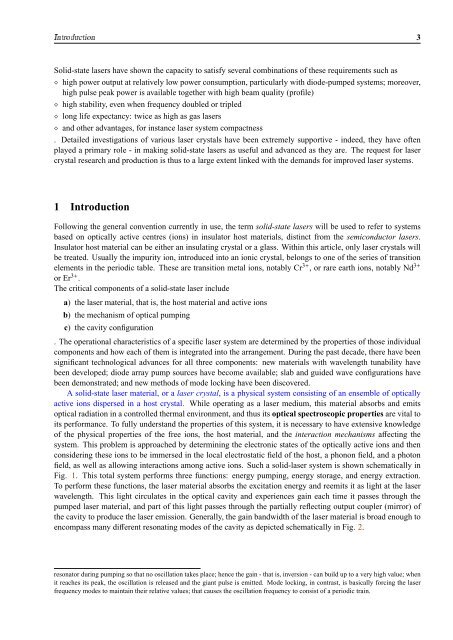moj seminar P ... - F9
moj seminar P ... - F9
moj seminar P ... - F9
Create successful ePaper yourself
Turn your PDF publications into a flip-book with our unique Google optimized e-Paper software.
Introduction 3Solid-state lasers have shown the capacity to satisfy several combinations of these requirements such as⋄ high power output at relatively low power consumption, particularly with diode-pumped systems; moreover,high pulse peak power is available together with high beam quality (profile)⋄ high stability, even when frequency doubled or tripled⋄ long life expectancy: twice as high as gas lasers⋄ and other advantages, for instance laser system compactness. Detailed investigations of various laser crystals have been extremely supportive - indeed, they have oftenplayed a primary role - in making solid-state lasers as useful and advanced as they are. The request for lasercrystal research and production is thus to a large extent linked with the demands for improved laser systems.1 IntroductionFollowing the general convention currently in use, the term solid-state lasers will be used to refer to systemsbased on optically active centres (ions) in insulator host materials, distinct from the semiconductor lasers.Insulator host material can be either an insulating crystal or a glass. Within this article, only laser crystals willbe treated. Usually the impurity ion, introduced into an ionic crystal, belongs to one of the series of transitionelements in the periodic table. These are transition metal ions, notably Cr 3+ , or rare earth ions, notably Nd 3+or Er 3+ .The critical components of a solid-state laser includea) the laser material, that is, the host material and active ionsb) the mechanism of optical pumpingc) the cavity configuration. The operational characteristics of a specific laser system are determined by the properties of those individualcomponents and how each of them is integrated into the arrangement. During the past decade, there have beensignificant technological advances for all three components: new materials with wavelength tunability havebeen developed; diode array pump sources have become available; slab and guided wave configurations havebeen demonstrated; and new methods of mode locking have been discovered.A solid-state laser material, or a laser crystal, is a physical system consisting of an ensemble of opticallyactive ions dispersed in a host crystal. While operating as a laser medium, this material absorbs and emitsoptical radiation in a controlled thermal environment, and thus its optical spectroscopic properties are vital toits performance. To fully understand the properties of this system, it is necessary to have extensive knowledgeof the physical properties of the free ions, the host material, and the interaction mechanisms affecting thesystem. This problem is approached by determining the electronic states of the optically active ions and thenconsidering these ions to be immersed in the local electrostatic field of the host, a phonon field, and a photonfield, as well as allowing interactions among active ions. Such a solid-laser system is shown schematically inFig. 1. This total system performs three functions: energy pumping, energy storage, and energy extraction.To perform these functions, the laser material absorbs the excitation energy and reemits it as light at the laserwavelength. This light circulates in the optical cavity and experiences gain each time it passes through thepumped laser material, and part of this light passes through the partially reflecting output coupler (mirror) ofthe cavity to produce the laser emission. Generally, the gain bandwidth of the laser material is broad enough toencompass many different resonating modes of the cavity as depicted schematically in Fig. 2.resonator during pumping so that no oscillation takes place; hence the gain - that is, inversion - can build up to a very high value; whenit reaches its peak, the oscillation is released and the giant pulse is emitted. Mode locking, in contrast, is basically forcing the laserfrequency modes to maintain their relative values; that causes the oscillation frequency to consist of a periodic train.















